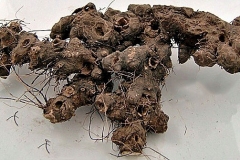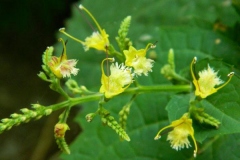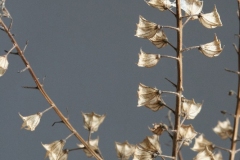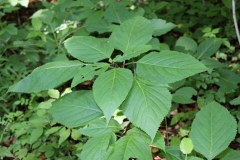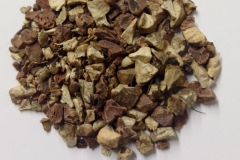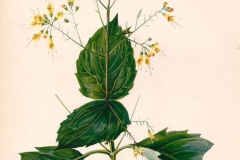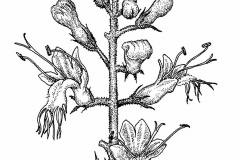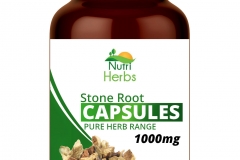| Stone Root Quick Facts | |
|---|---|
| Name: | Stone Root |
| Scientific Name: | Collinsonia canadensis |
| Origin | Eastern North America from Quebec south to Florida and as far west as Missouri |
| Colors | Dark brown |
| Shapes | Small nutlets about 1.5 mm. across, globoid but somewhat flattened in shape containing four seeds |
| Taste | Pungent and spicy taste |
| Health benefits | Supports Circulation, Antioxidant Action, Cure Sore Throat, Hemorrhoids, Supports Digestion, Mental Health, Alleviate kidney and urinary tract infections, |
| Name | Stone Root |
|---|---|
| Scientific Name | Collinsonia canadensis |
| Native | Eastern North America from Quebec south to Florida and as far west as Missouri, although it is mainly found east of the Mississippi River |
| Common Names | Stoneroot, horsebalm, broadleaf collinsonia, hard hack, heal-all, horse weed, knobroot, ox balm, richweed, Hardback, Hardhack, Knob Grass, Knobweed, Racine de Pierre, Richleaf, Rich Weed |
| Name in Other Languages | Arabic: Kwlnsunyat kandi (كولنسونية كندية) Dutch: Canadees steenkruid, paardenbalsem English: Canada horse balm, hardhack, heal-all, horseweed, ox-balm, richweed, stone root, Northern horsebalm, Horsebalm, deepwoods horsebalm French: Collinsonia, Collinsonie du Canada German: Griesswurzel, kanadische Collinsonia, Steinwurzel Italian: Balsamo del cavallo Portuguese: Collinsonia Russian: kamennyy koren (каменный корень), kollinsoniya kanadskaya (коллинсония канадская) Spanish: Hierba collinsonia, raíz de la piedra Swedish: Hästmynta |
| Plant Growth Habit | Upright perennial |
| Growing Climates | Woodlands, rocky upland woodlands, wooded areas in rocky river valleys, and less often elevated areas in swamps. This plant tends to occur in oak-hickory woodlands and beech-maple woodlands, especially in areas where sandstone bedrock |
| Soil | Easily grown in average, medium, well-drained soil in part shade. Does well in sandy, clay soils |
| Plant Size | 2 to 4 feet high |
| Rhizome | Brown-grey, about 4 inches long, knobby, and very hard |
| Stem | Square stem, smooth, or slightly pubescent, somewhat branching at the top, and growing from 2 to 4 feet high |
| Leaf | Leaves are ovate in shape, acuminate apex, coarsely serrated margins, and borne on long petioles. They have a distinct lemon-like smell when crushed. |
| Flowering season | July to September |
| Flower | Flowers are light yellow and fragrant, bilabiate in shape and mainly arranged in terminal panicles. Two stamens bearing red anthers protrude beyond the lower lip of the corolla |
| Fruit Shape & Size | Small nutlets about 1.5 mm. across, globoid but somewhat flattened in shape containing four seeds |
| Fruit Color | Dark brown |
| Flavor/Aroma | Strong, disagreeable odor |
| Taste | Pungent and spicy taste |
| Plant Parts Used | Whole plant, fresh root |
| Available Forms | Capsules, tinctures, liquid extract and tea |
| Health Benefits |
|
| Culinary Uses |
|
Plant Description
Stone root is an upright perennial herb that normally grows about 2 to 4 feet tall. The plant is found growing in woodlands, rocky upland woodlands, wooded areas in rocky river valleys, and less often elevated areas in swamps. This plant tends to occur in oak-hickory woodlands and beech-maple woodlands, especially in areas where sandstone bedrock. It is also grown in nutrient-rich mesic forests, most often in rocky, calcareous areas. The plant is easily grown in average, medium, well-drained soil in part shade. Similarly it does well in sandy, clay soils. Rhizomes are brown-grey, about 4 inches long, knobby, and very hard. Square stem is smooth, or slightly pubescent, somewhat branching at the top, and growing from 2 to 4 feet high.
Leaves
Leaves are 2–6 inches long, 1½–4 inches across, usually ovate in shape, and coarsely serrate-crenate along their margins. The leaf tips are usually acute, while the leaf bases are wedge-shaped (cuneate) to rounded. Upper leaf surface is medium to dark green and hairless to sparsely short-pubescent, while the lower leaf surface is light grayish green, hairless to sparsely pubescent, and glandular-punctate (appearing like glistening dots in bright light). The narrow petioles are ½–2 inches long, light green, and hairless to moderately short-pubescent; sometimes the uppermost leaves are sessile or nearly so.
Flower
Central stem terminates in either a spike-like raceme or pyramidal panicle of flowers (depending on the robustness of individual plants). Individual panicles are up to 8 inches long and 6 inches across, consisting of a central stalk and several lateral branches that become progressively shorter upward. These lateral branches are spreading to ascending. Both the central stalk and lateral branches of the inflorescence are light green and bluntly 4-angled with shallow channels along their sides. They are hairless to moderately short-pubescent. The inflorescence also has small green bracts that are less than 1/8″ (3 mm.) long; they are narrow in shape and early-deciduous.
Individual flowers are about 1/3–1/2 inches (8–13 mm.) long, consisting of a short-tubular to bell-shaped green calyx with 5 teeth, a two-lipped tubular corolla that is predominately cream-colored or yellow, 2 long-exserted fertile stamens, and an ovary with a slender style that is also long-exserted. The calyx is minutely pubescent and glandular-punctate, it has 2 linear-lanceolate lower teeth and 3 linear-deltate upper teeth; the lower teeth are longer than the upper teeth. The calyx also has 10 narrow longitudinal ridges that are dark green. Corolla has a narrow tubular base, but it becomes wider and more trumpet-shaped towards its mouth with 5 spreading lobes (2 upper lobes, 2 lateral lobes, and 1 lower lobe that is larger in size). The upper and lateral lobes are either oval or oval-deltate in shape, while the lower lobe is violin-shaped, mostly white, and heavily fringed along its outer lip. Sometimes there are reddish stripes or bars along the upper and middle lobes of the corolla, while either patches or stripes of faded red may occur toward the base of the lower lobe. The throat of the corolla is a little wider than tall, where there is a patch of fine white hairs. The filaments of the stamens are white, light yellow or light greenish yellow, while the fertile anthers are either white or light yellow. The slender style is dark red and usually bent toward one of the stamens.
Fruit
Afterwards, the flowers are replaced by small nutlets (0-2 nutlets per flower); they develop within enlarged calyces. Individual nutlets are about 1.5 mm. across, globoid but somewhat flattened in shape, and dark brown. Each nutlet consists of about four seeds.
Health benefits of Stone Root
Collinsonia canadensis, also known as stone root is an herb in the mint family. Traditionally, it has been used for improving circulation and congestion, particularly in the bowels and throat. It has also generated much interest for being helpful in keeping mucous membranes healthy and improving digestion. In the past, it was an extremely valuable ingredient in many types of throat remedies. In particular though, due to its usefulness in promoting circulation, it is believed to be valuable in relieving hemorrhoid symptoms. Listed below are some of the popular health benefits of stone root
1. Supports Circulation
Collinsonia root is supposed to help with a number of circulatory conditions, including easing hemorrhoid pain. It is considered to help with rectal irritation by fighting the swelling of rectal veins. It’s also known to assist in blood flow by alleviating blood vessel contraction, strengthening vein walls, and assisting with the reduction of blood pooling. Many people, who have circulatory concerns that cause them to feel cold all the time, even when the weather is warm, use this herb to gain relief from chills.
2. Antioxidant Action
Collinsonia possesses strong antioxidant properties, containing the beneficial elements of saponins, organic acid, mucilage, tannins, and resins. These substances help support blood vessel tone, organ tissues, and fluid levels. By assisting the body in overcoming circulatory conditions and stress, Collinsonia supports lung and heart health. It has a natural ability to assist in the removal of excess fluids. Because of this, some people also use it to maintain urinary health.
3. Cure Sore Throat
Collinsonia root is quite beneficial for throat and the larynx. Since the late 19th Century, many natural health practitioners have trusted upon Canadensis for a condition that was once known as “minister’s sore throat.” This condition was observed to result in those who, like ministers often did in the late 19th century, spoke for prolonged periods in a strained, ecstatic, or exaggerated tone of voice that resulted in congestion of the vocal cords. This condition would then produce a sense of restriction, coughing, and even the inability to speak. People with this condition reported instant relief after taking Collinsonia Root.
4. Hemorrhoids
In the 21st century, collinsonia root is most commonly used in natural health care for the treatment of hemorrhoids (a condition of vascular irritation of the rectal area with a general sense of “constriction” or pain in the lower abdomen). Collinsonia root is used in particular for symptomatic hemorrhoids, the most common complaint in anus and rectal health issues. Symptoms can include rectal bleeding, tissue protrusion, and mucous discharge.
Other herbs used to treat hemorrhoid pain include butcher’s broom (Ruscus aculeatus), horse chestnut (Aesculus hippocastanum), witch hazel (Hamamelis virginiana), arnica (Arnica spp.), oak (Quercus spp.), chamomile (Matricaria recutita), gotu kola (Centella asiatica), calendula (Calendula officinalis), and psyllium (Plantago ovata seed).
5. Supports Digestion
Nowadays Collinsonia root is used to relieve the heartburn and painful digestion associated with circulatory stress. In fact, it appears to help with several conditions that often impact the entire digestive process. Reports have circulated that it helps relieve symptoms of diarrhea, constipation, and flatulence. Athletes have used this herb to help them regain energy after intense performances that led to overexertion.
6. Mental Health
Number of mental issues appears to be relieved by the use of this herb. Overall feelings of happiness and decreased nervousness have been reported by a number of users. Other reports also mention increased female libido, better energy, and better skin.
7. Alleviate kidney and urinary tract infections
It is collinsonia root’s earlier-referenced diuretic characteristics that stimulate urine production and the regularity of urination. It is also beneficial in easing painful inflammation of the bladder as well as kidney stones, while also proving helpful in eliminating accumulated toxic uric acid and relieving water retention.
8. Other Benefits of Collinsonia Root
The benefits of Collinsonia root are available from both internal and topical applications. As a poultice, it has been used for bruises, joint aches, and sprains. The flowers and leaves of the plant have also been used to relieve headaches and body odor. When taken internally, it helps with headaches, cramps, and indigestion. Others have used it for kidney and urinary benefits. Other applications include easing the symptoms of sore throats, helping to clear chest congestion, assisting with digestive difficulties, and eliminating constipation.
Traditional uses and benefits of Stone Root
- Whole plant especially the fresh root, is alterative, antispasmodic, diaphoretic, diuretic, sedative, tonic, vasodilator and vulnerary.
- Tea made from the roots is strongly diuretic; it is valuable in the treatment of all complaints of the urinary system and the rectum and is used in the treatment of piles, indigestion, diarrhea, kidney complaints etc.
- It has proved beneficial in the treatment of irritable bowel syndrome, mucous colitis and varicose veins.
- Root is occasionally used on its own but is contained in remedies with other herbs, mainly Aphanes arvensis, Eupatorium purpureum and Hydrangea arborescens.
- Fresh leaves are strongly emetic.
- Poultice of the leaves or roots is applied to burns, bruises, sores, sprains etc.
- Decoction of the fresh root has been given in catarrh of the bladder, leucorrhea, gravel and dropsy.
- It is valuable in all complaints of urinary organs and rectum, and is best combined with other drugs.
- It can be used externally, especially the leaves, for poultices and fomentations, bruises, wounds, sores, cuts, etc., and also as a gargle, in the strength of 1 part of fluid extract to 3 of water.
- Stone Root was used by Native Americans to treat a variety of ailments.
- An infusion of the aerial parts is used for headaches and rheumatism.
- When used as a poultice, it is reported to treat bruises, wounds, sprains, and contusions.
- When taken internally as an infusion, it relieves headaches, colic, cramps, dropsy and indigestion.
- It was applied topically for a number of dermatological issues, including boils and swollen breasts, and as a treatment for headaches.
- As a leg and foot soak it was also considered useful for rheumatism.
- Decoction of the root was used for kidney or heart troubles.
- It was commonly used as a dermatological, kidney and mucous membrane aide, and for cases of mild diarrhea to tonify weak and depleted tissues.
- Topically, it was applied to any swollen areas of the skin and considered an excellent application for sprains and bruises.
- It was also used for chronic laryngitis, chronic bronchitis, and phthisis – allaying irritation and checking cough, making this are liable remedy for nearly all afflictions of the throat and lungs.
- Scudder also used this as a secondary digestive aide for improving appetite and digestion.
- It was one of the preferred herbal choices for stagnation and for irritated mucous membranes.
- Being mildly astringent, it was used in early stages of hemorrhoids.
- It was considered to have a profound stimulating effect on the heart, strengthening the capillary flow and improving circulation throughout the body.
- It is regarded as a specific remedy for pelvic and portal congestion, and for dull headaches related with suppressed hemorrhoids.
- It is particularly indicted for females with organ prolapse and congestive dysmenorrhea.
- It is recorded for catarrh of the bladder, leucorrhea, gravel, and dropsy when administered as a decoction.
- It is effective for promoting expulsion of urinary calculi, diminishing irritation in the bladder and urethra and assisting in the treatment of acute cystitis and enuresis.
- Leaves are traditionally used as a poultice to treat sprains, burns, bruises, ulcers, and other wounds, as it may improve capillary function and support speedy healing.
- Rhizome of stone root is brewed to prepare an herbal tea which served as a home-made remedy for constipation and headaches.
- Stone root is a very effective medication for treating tender throat, laryngitis, pharyngitis accompanied by relaxed as well as weakened circulation of the capillary.
- Stone root is also taken internally following evening meal or prior to going to bed at night to treat incontinence of urine.
- It is also used for various medical problems endured by females, especially menorrhagia, dysmenorrhea, prolapsed uterus, threatened abortion, vicarious menstruation, leucorrhea as well as pruritis-vulvae owing to varicose or varicosity.
- Bruised leaves were applied as a poultice in burns, bruises, wounds, ulcers, sores, sprains, contusions, and for internal abdominal ailments.
Ayurvedic Health benefits of Stone Root
- Kidney: Prepare a decoction of dried stone root. Take half cup lukewarm decoction daily.
- Constipation: Add one to three teaspoonful of the dried rhizomes of stone root in a cup of water and boil it. Simmer for 15 minutes. Filter and drink thrice a day.
- Rectal Prolapse: Prepare a decoction by boiling 1 tsp. of dried stone root in one cup of water. Drink it twice a day.
- Kidney stones: Stones may be treated by administering a combo of stone root, parsley piert, gravel root, Parietaria Judaica, hydrangea.
- Kidney stone: take equal amount of hydrangea root, stone root, bearberry and gravel root. Powder them together. Have one tsp. with lukewarm water once a day.
Precautions
- Minute doses of the fresh leaves can cause vomiting, though the root is well-tolerated by the body.
- Possible blood pressure elevation.
- It may cause Nausea and dizziness.
- Avoid use during pregnancy and breast feeding.
- Excess use may cause vomiting.
- Taking large amounts of stone root can cause some side effects such as dizziness, nausea, painful urination, and stomach irritation.
- Stone root may interact with your current medications or medical conditions. Consult with your herbalist or doctor before using.
References:
https://gd.eppo.int/taxon/CIZCA
https://www.itis.gov/servlet/SingleRpt/SingleRpt?search_topic=TSN&search_value=32474#null
https://pfaf.org/user/Plant.aspx?LatinName=Collinsonia+canadensis
http://www.missouribotanicalgarden.org/PlantFinder/PlantFinderDetails.aspx?kempercode=j860
https://npgsweb.ars-grin.gov/gringlobal/taxonomydetail.aspx?423713
https://plants.usda.gov/core/profile?symbol=COCA4
https://www.botanical.com/botanical/mgmh/s/stoner92.html
https://en.wikipedia.org/wiki/Collinsonia_canadensis
http://www.theplantlist.org/tpl1.1/record/kew-46224



